Jackson M.J. Micro and Nanomanufacturing
Подождите немного. Документ загружается.

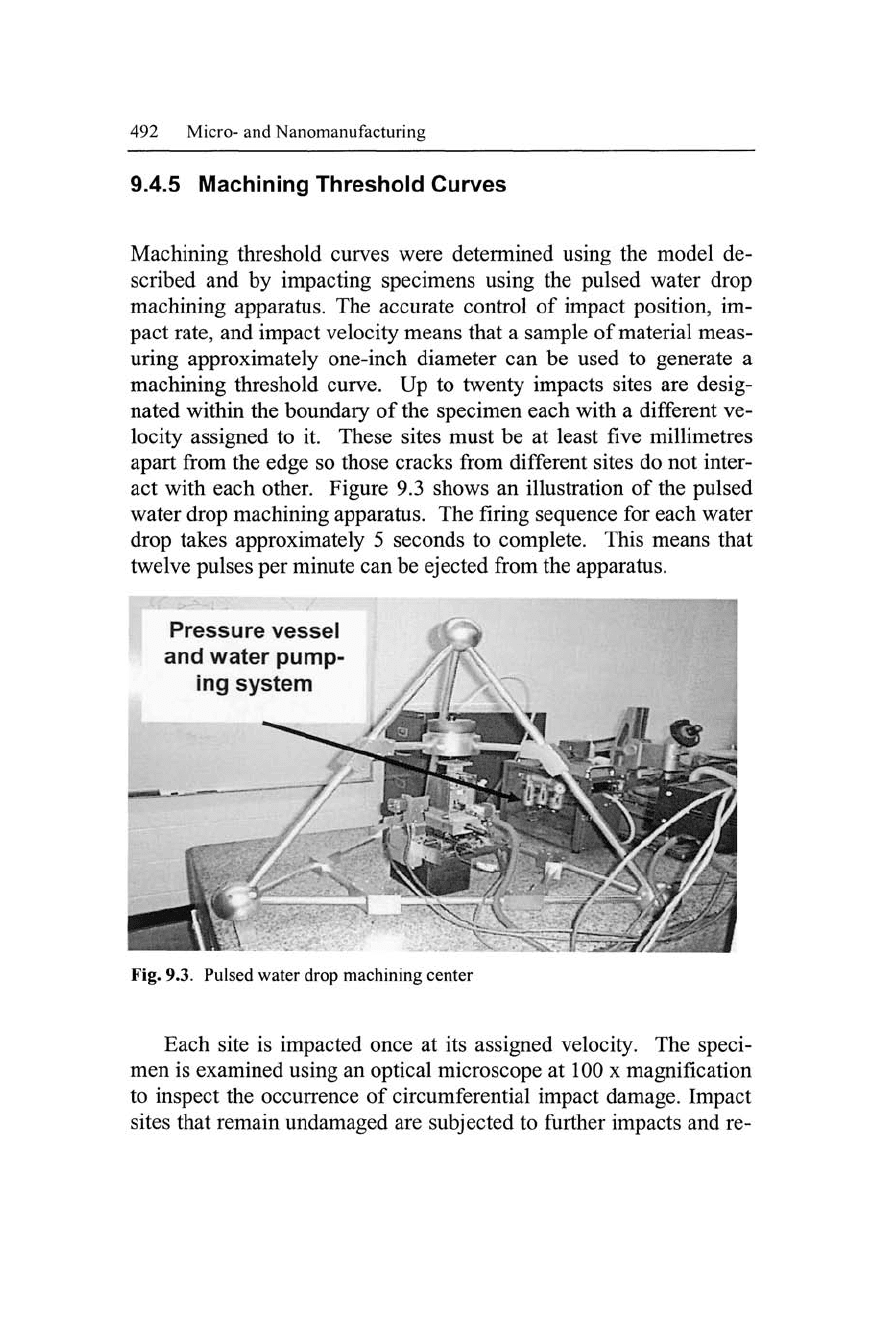
492 Micro- and Nanomanufacturing
9,4.5 Machining Threshold Curves
Machining threshold curves were determined using the model de-
scribed and by impacting specimens using the pulsed water drop
machining apparatus. The accurate control of impact position, im-
pact rate, and impact velocity means that a sample of material meas-
uring approximately one-inch diameter can be used to generate a
machining threshold curve. Up to twenty impacts sites are desig-
nated within the boundary of the specimen each with a different ve-
locity assigned to it. These sites must be at least five millimetres
apart from the edge so those cracks from different sites do not inter-
act with each other. Figure 9.3 shows an illustration of the pulsed
water drop machining apparatus. The firing sequence for each water
drop takes approximately 5 seconds to complete. This means that
twelve pulses per minute can be ejected from the apparatus.
Fig. 9.3. Pulsed water drop machining center
Each site is impacted once at its assigned velocity. The speci-
men is examined using an optical microscope at 100 x magnification
to inspect the occurrence of circumferential impact damage. Impact
sites that remain undamaged are subjected to further impacts and re-
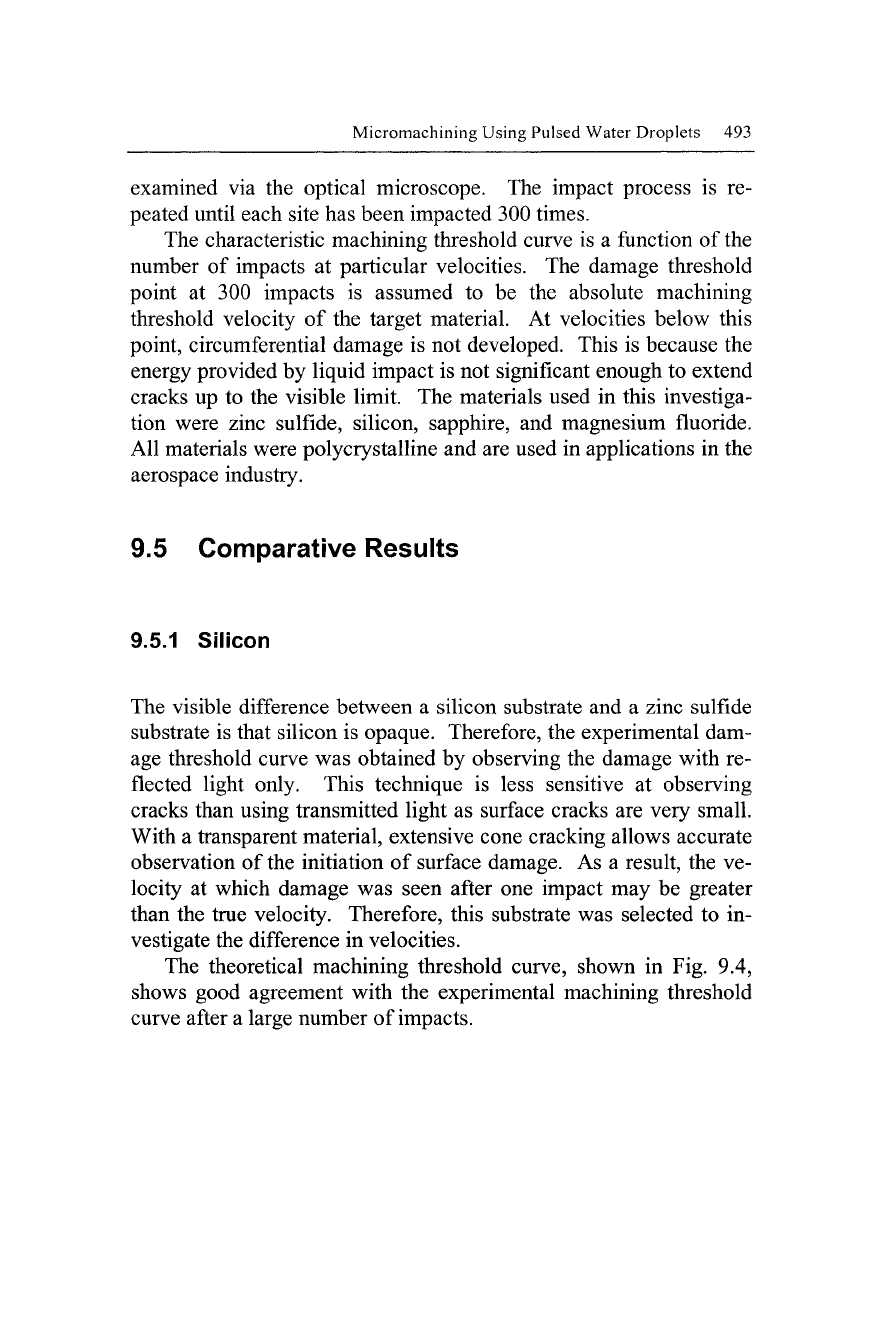
Micromachining Using Pulsed Water Droplets 493
examined via the optical microscope. The impact process is re-
peated until each site has been impacted 300 times.
The characteristic machining threshold curve is a function of the
number of impacts at particular velocities. The damage threshold
point at 300 impacts is assumed to be the absolute machining
threshold velocity of the target material. At velocities below this
point, circumferential damage is not developed. This is because the
energy provided by liquid impact is not significant enough to extend
cracks up to the visible limit. The materials used in this investiga-
tion were zinc sulfide, silicon, sapphire, and magnesium fluoride.
All materials were polycrystalline and are used in applications in the
aerospace industry.
9.5 Comparative Results
9.5.1 Silicon
The visible difference between a silicon substrate and a zinc sulfide
substrate is that silicon is opaque. Therefore, the experimental dam-
age threshold curve was obtained by observing the damage with re-
flected light only. This technique is less sensitive at observing
cracks than using transmitted light as surface cracks are very small.
With a transparent material, extensive cone cracking allows accurate
observation of the initiation of surface damage. As a result, the ve-
locity at which damage was seen after one impact may be greater
than the true velocity. Therefore, this substrate was selected to in-
vestigate the difference in velocities.
The theoretical machining threshold curve, shown in Fig. 9.4,
shows good agreement with the experimental machining threshold
curve after a large number of impacts.
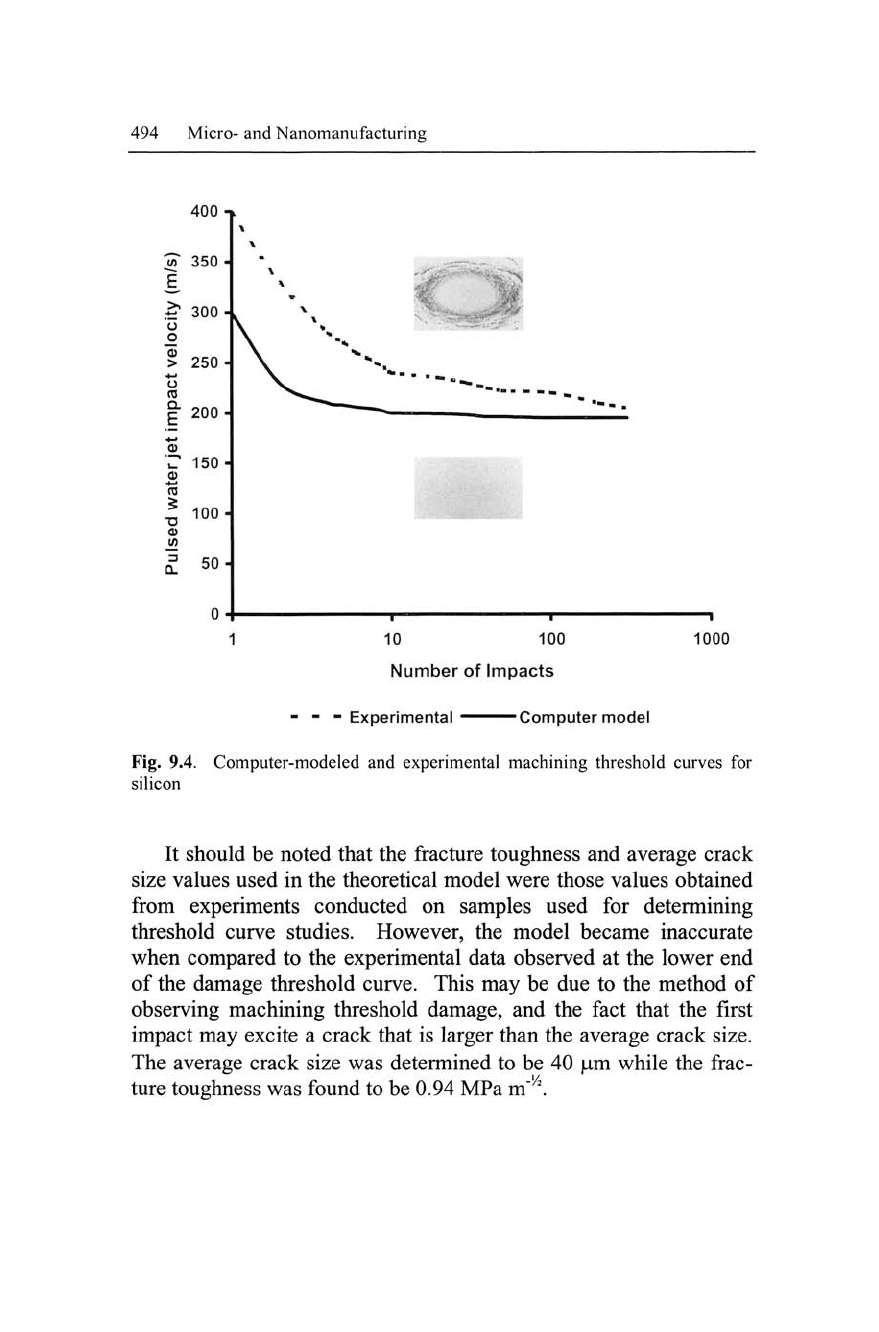
494 Micro- and Nanomanufacturing
400
In 350
£ 300
o
o
(D
> 250
•+•»
o
re
| 200
"5
r 150
I 100
CD
I 50
0
1 10 100 1000
Number of Impacts
- - - Experimental Computer model
Fig. 9.4. Computer-modeled and experimental machining threshold curves for
silicon
It should be noted that the fracture toughness and average crack
size values used in the theoretical model were those values obtained
from experiments conducted on samples used for determining
threshold curve studies. However, the model became inaccurate
when compared to the experimental data observed at the lower end
of the damage threshold curve. This may be due to the method of
observing machining threshold damage, and the fact that the first
impact may excite a crack that is larger than the average crack size.
The average crack size was determined to be 40 |um while the frac-
ture toughness was found to be 0.94 MPa m'
y
\
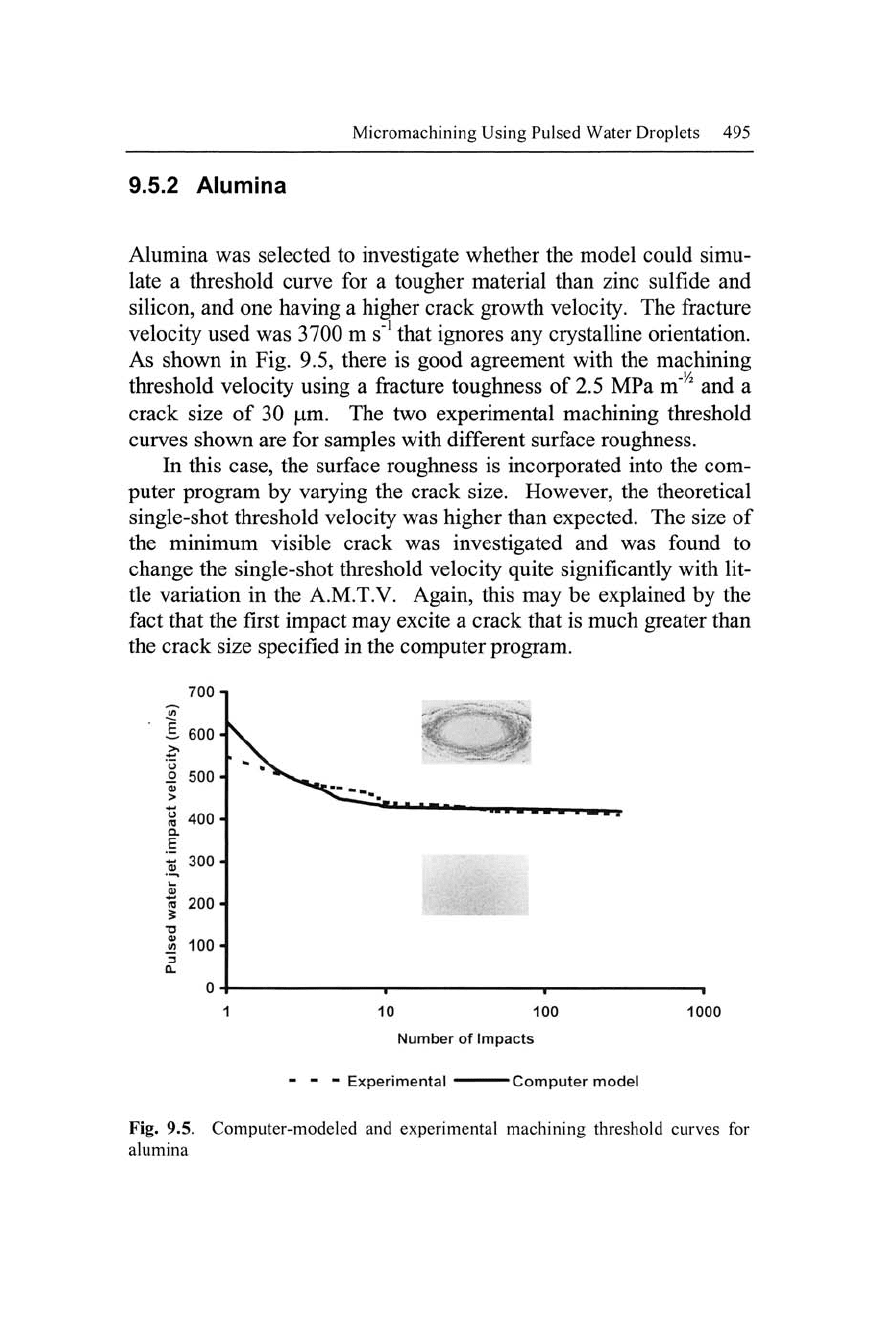
Micromachining Using Pulsed Water Droplets 495
9.5.2 Alumina
Alumina was selected to investigate whether the model could simu-
late a threshold curve for a tougher material than zinc sulfide and
silicon, and one having a higher crack growth velocity. The fracture
velocity used was 3700 m
s"
1
that ignores any crystalline orientation.
As shown in Fig. 9.5, there is good agreement with the machining
threshold velocity using a fracture toughness of 2.5 MPa m'
/2
and a
crack size of 30 |um. The two experimental machining threshold
curves shown are for samples with different surface roughness.
In this case, the surface roughness is incorporated into the com-
puter program by varying the crack size. However, the theoretical
single-shot threshold velocity was higher than expected. The size of
the minimum visible crack was investigated and was found to
change the single-shot threshold velocity quite significantly with lit-
tle variation in the A.M.T.V. Again, this may be explained by the
fact that the first impact may excite a crack that is much greater than
the crack size specified in the computer program.
700-
! 600 -
1 500-
m
>
S 400-
Q.
E
% 300-
i_
0
« 200-
3
lOO-
Q_
0-
1 10 100 1000
Number of Impacts
" - " Experimental Computer model
Fig. 9.5. Computer-modeled and experimental machining threshold curves for
alumina
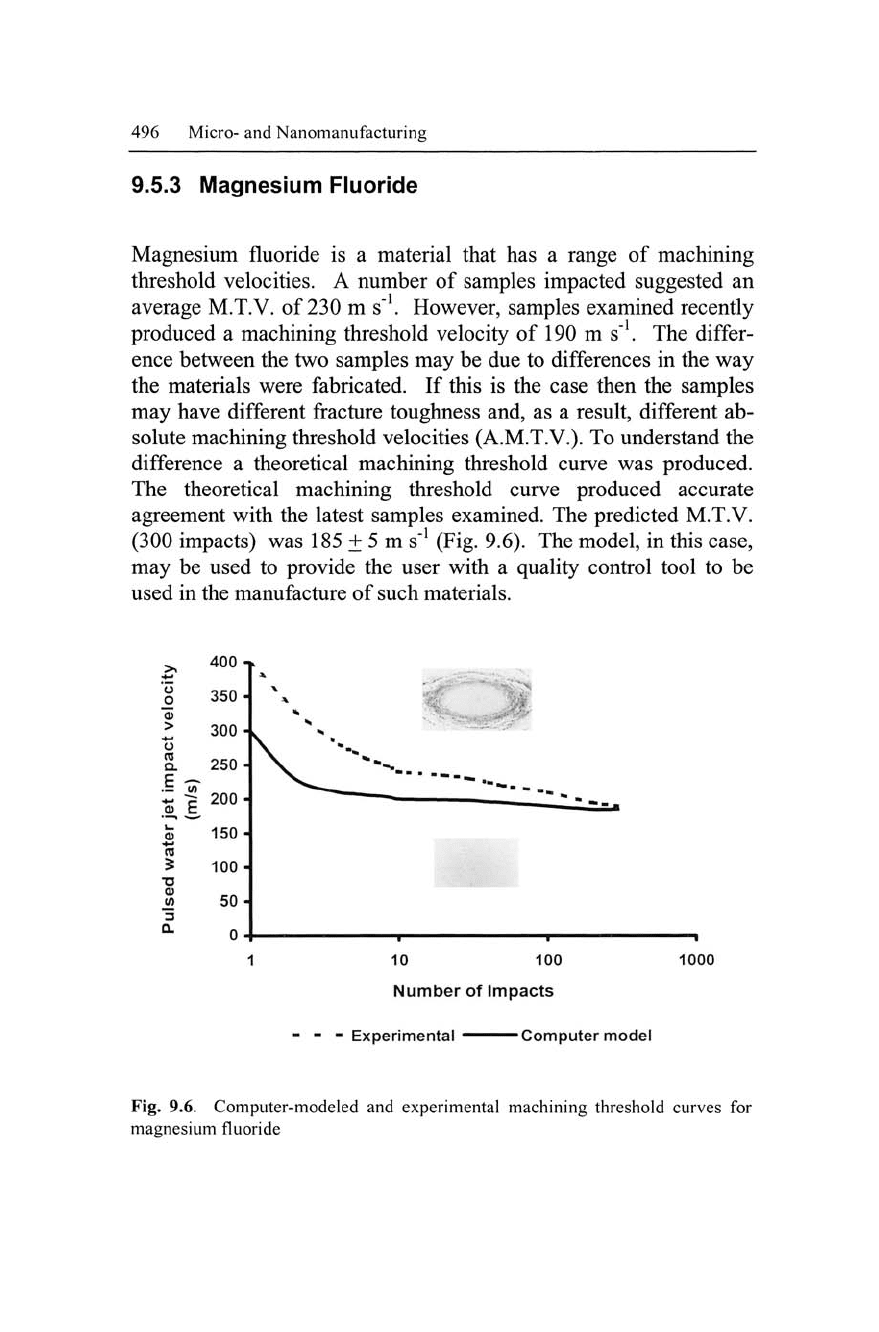
496 Micro- and Nanomanufacturing
9.5.3 Magnesium Fluoride
Magnesium fluoride is a material that has a range of machining
threshold velocities. A number of samples impacted suggested an
average M.T.V. of 230 m s'
1
. However, samples examined recently
produced a machining threshold velocity of 190 m s"
1
. The differ-
ence between the two samples may be due to differences in the way
the materials were fabricated. If this is the case then the samples
may have different fracture toughness and, as a result, different ab-
solute machining threshold velocities (A.M.T.V.). To understand the
difference a theoretical machining threshold curve was produced.
The theoretical machining threshold curve produced accurate
agreement with the latest samples examined. The predicted M.T.V.
(300 impacts) was 185 + 5 m s"
1
(Fig. 9.6). The model, in this case,
may be used to provide the user with a quality control tool to be
used in the manufacture of such materials.
^
>•->
o
o
CD
>
+-
o
Q.
an
0)
0)
+->
ro
5
•D
CI)
</)
3
0-
(/>
£
400
350
300
250
200
150
100
60
0
1 10 100 1000
Number of Impacts
- - - Experimental Computer model
Fig. 9.6. Computer-modeled and experimental machining threshold curves for
magnesium fluoride
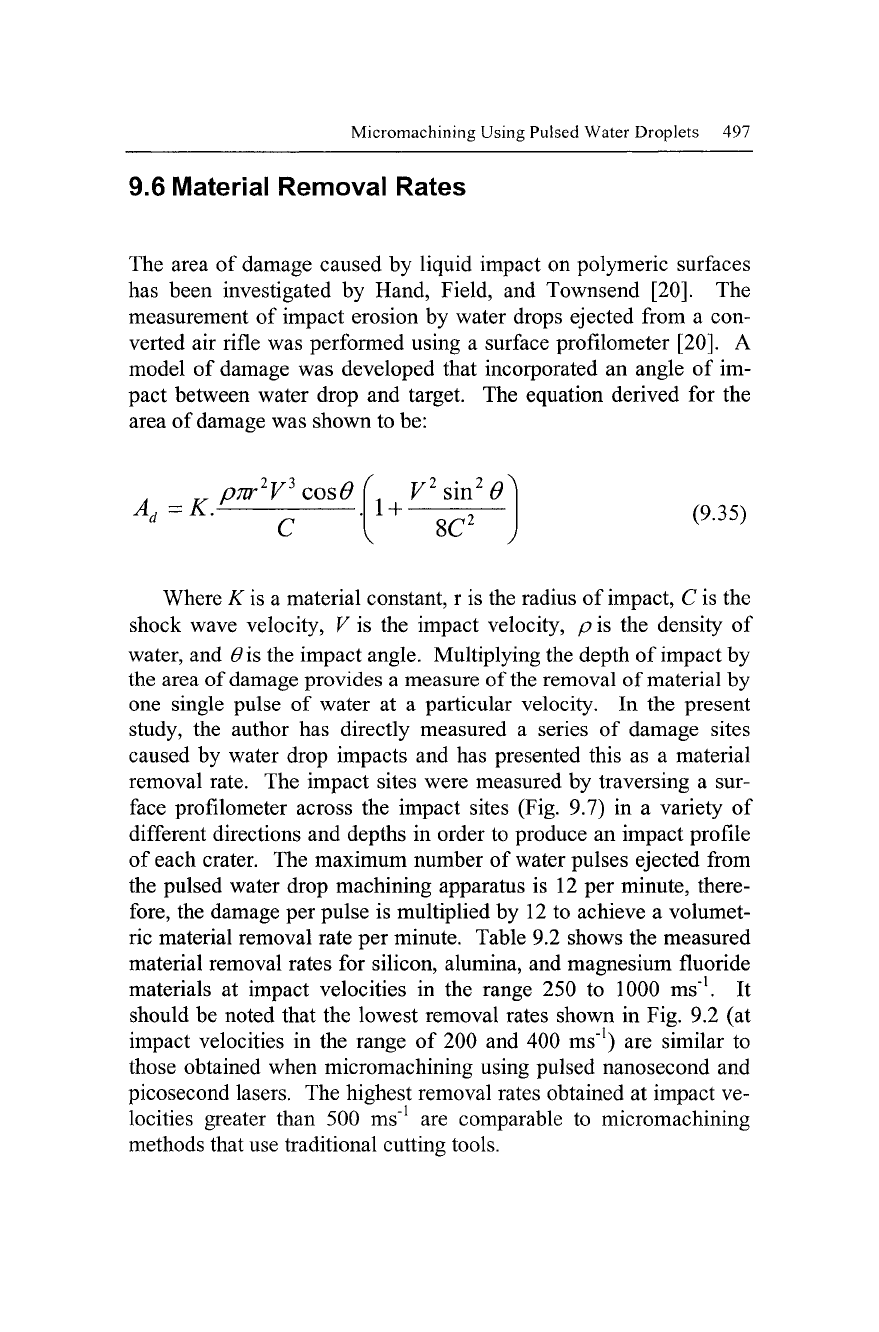
Micromachining Using Pulsed Water Droplets
497
9.6 Material Removal Rates
The area of damage caused by liquid impact on polymeric surfaces
has been investigated
by
Hand, Field, and Townsend [20].
The
measurement of impact erosion by water drops ejected from
a
con-
verted air rifle was performed using
a
surface profilometer [20].
A
model of damage was developed that incorporated an angle
of
im-
pact between water drop and target. The equation derived for the
area of damage was shown to be:
*<•*•—c—r-&-)
(9
-
35)
Where K is a material constant,
r
is the radius of impact, C is the
shock wave velocity, V is the impact velocity,
p
is the density
of
water, and 6 is the impact angle. Multiplying the depth of impact by
the area of damage provides a measure of the removal of material by
one single pulse
of
water
at a
particular velocity.
In
the present
study,
the
author has directly measured
a
series
of
damage sites
caused by water drop impacts and has presented this
as a
material
removal rate. The impact sites were measured by traversing
a
sur-
face profilometer across the impact sites (Fig. 9.7)
in a
variety
of
different directions and depths in order to produce an impact profile
of each crater. The maximum number of water pulses ejected from
the pulsed water drop machining apparatus is 12 per minute, there-
fore,
the damage per pulse is multiplied by 12 to achieve
a
volumet-
ric material removal rate per minute. Table 9.2 shows the measured
material removal rates for silicon, alumina, and magnesium fluoride
materials
at
impact velocities
in
the range 250
to
1000 ms'
1
.
It
should be noted that the lowest removal rates shown in Fig. 9.2 (at
impact velocities
in
the range
of
200 and 400 ms"
1
) are similar
to
those obtained when micromachining using pulsed nanosecond and
picosecond lasers. The highest removal rates obtained at impact ve-
locities greater than 500 ms"
1
are
comparable
to
micromachining
methods that use traditional cutting tools.
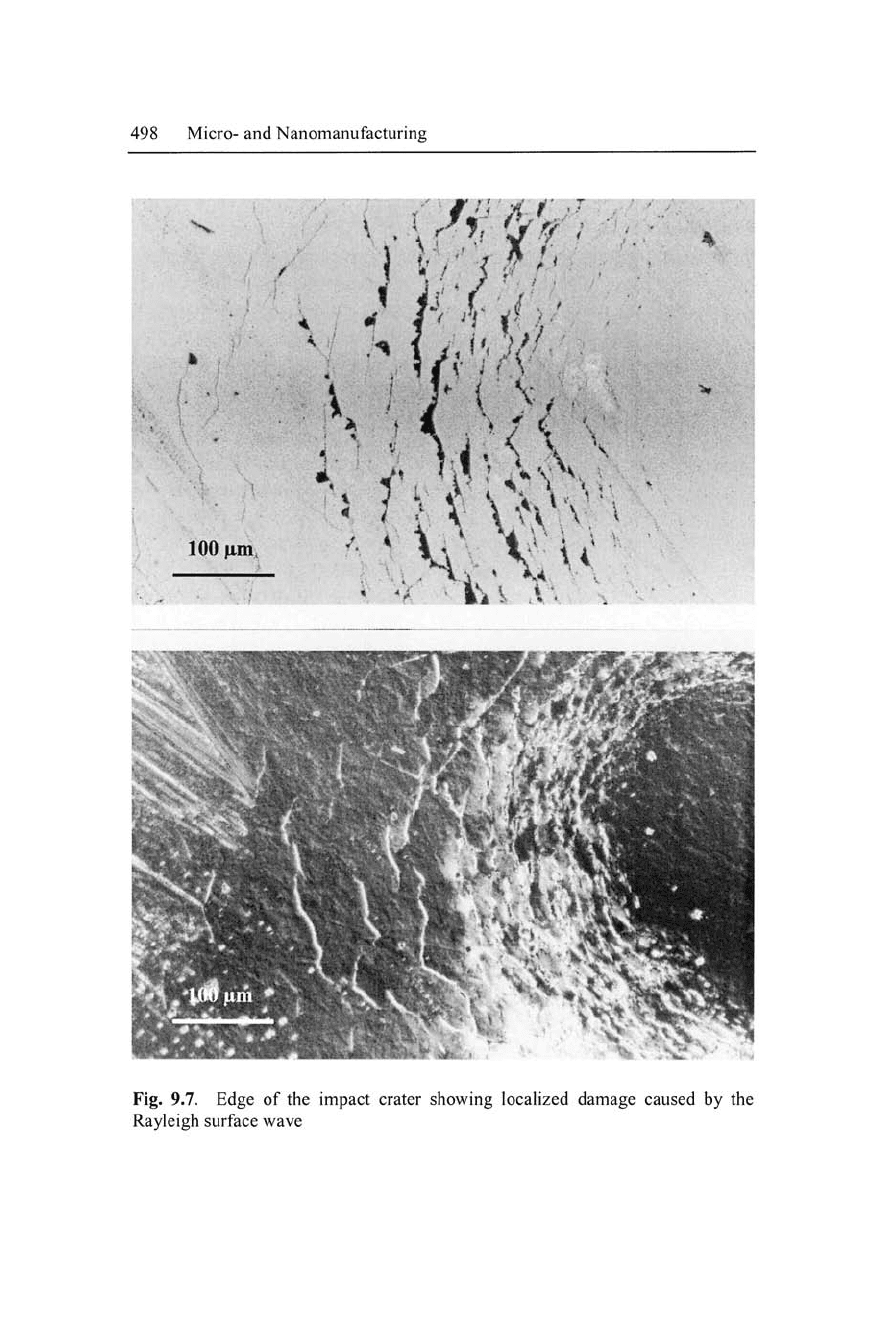
498 Micro- and Nanomanufacturing
100 pan,
• ' Vi vi A
s
Fig. 9.7. Edge of the impact crater showing localized damage caused by the
Rayleigh surface wave
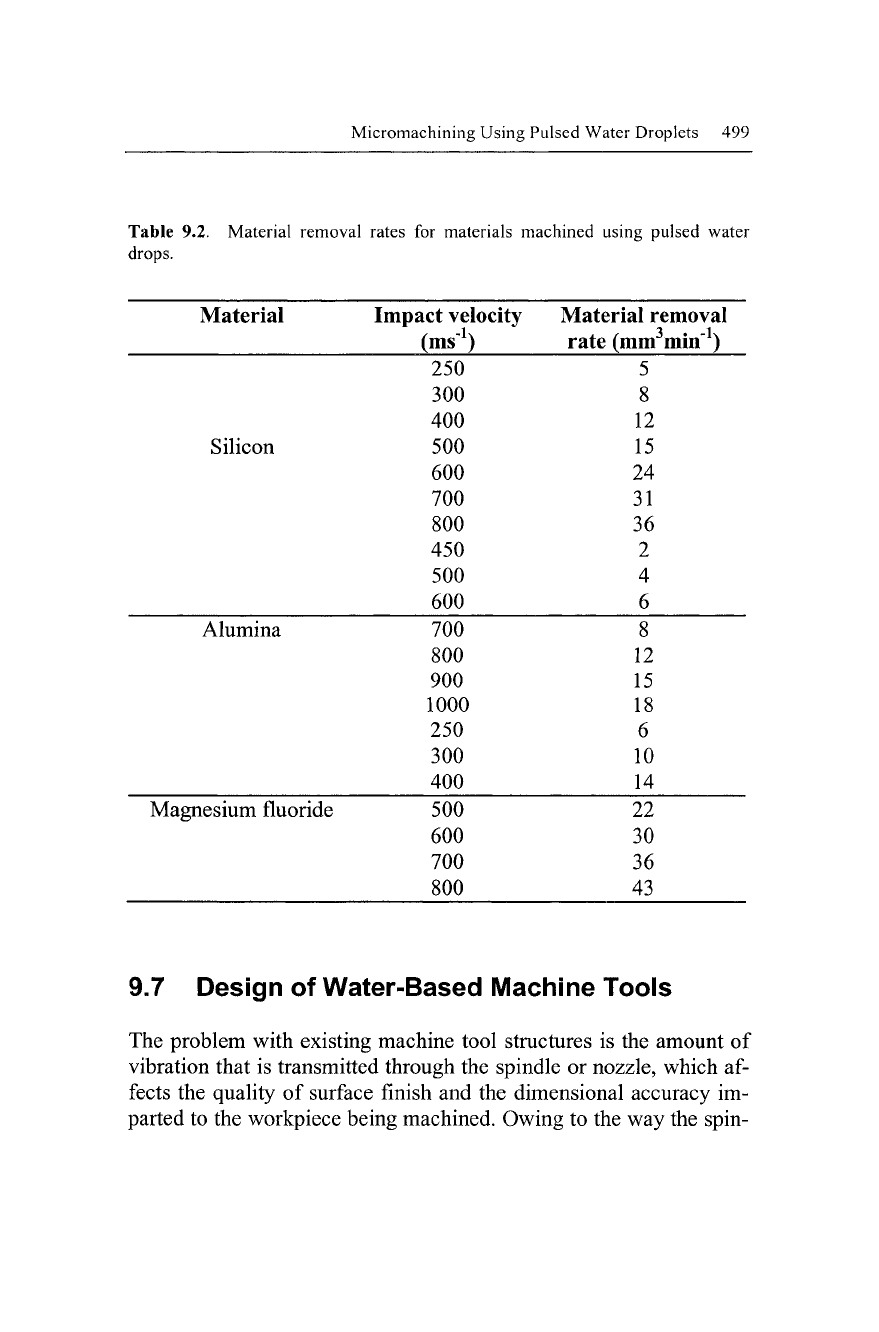
Micromachining Using Pulsed Water Droplets 499
Table 9.2. Material removal
drops.
Material
Silicon
Alumina
Magnesium fluoride
rates
for materials machined
Impact velocity
(ms"
1
)
250
300
400
500
600
700
800
450
500
600
700
800
900
1000
250
300
400
500
600
700
800
using pulsed water
Material removal
rate (mm
3
min"
1
)
5
8
12
15
24
31
36
2
4
6
8
12
15
18
6
10
14
22
30
36
43
9.7 Design of Water-Based Machine Tools
The problem with existing machine tool structures is the amount of
vibration that is transmitted through the spindle or nozzle, which af-
fects the quality of surface finish and the dimensional accuracy im-
parted to the workpiece being machined. Owing to the way the spin-
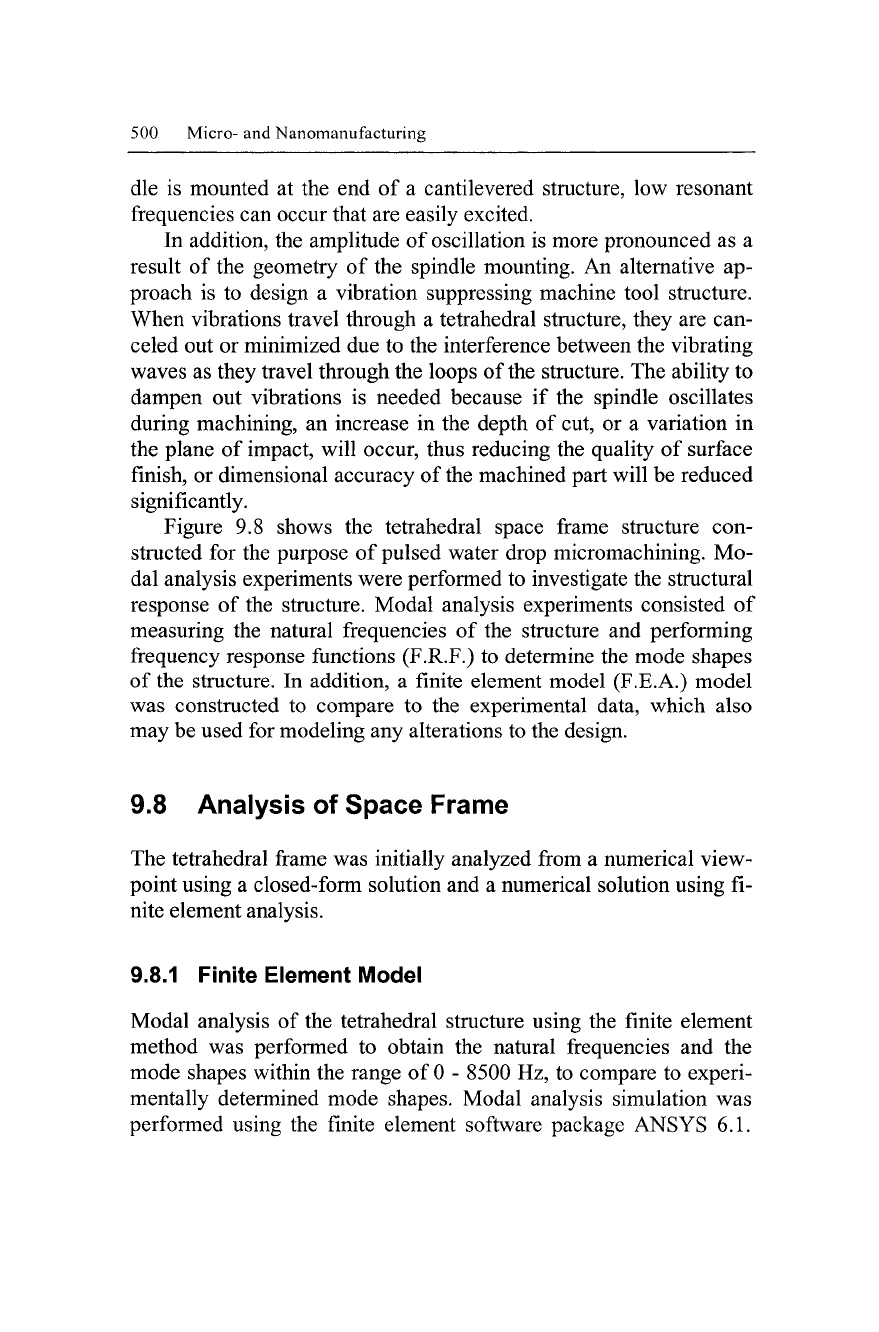
500 Micro- and Nan ©manufacturing
die is mounted at the end of a cantilevered structure, low resonant
frequencies can occur that are easily excited.
In addition, the amplitude of oscillation is more pronounced as a
result of the geometry of the spindle mounting. An alternative ap-
proach is to design a vibration suppressing machine tool structure.
When vibrations travel through a tetrahedral structure, they are can-
celed out or minimized due to the interference between the vibrating
waves as they travel through the loops of the structure. The ability to
dampen out vibrations is needed because if the spindle oscillates
during machining, an increase in the depth of cut, or a variation in
the plane of impact, will occur, thus reducing the quality of surface
finish, or dimensional accuracy of the machined part will be reduced
significantly.
Figure 9.8 shows the tetrahedral space frame structure con-
structed for the purpose of pulsed water drop micromachining. Mo-
dal analysis experiments were performed to investigate the structural
response of the structure. Modal analysis experiments consisted of
measuring the natural frequencies of the structure and performing
frequency response functions (F.R.F.) to determine the mode shapes
of the structure. In addition, a finite element model (F.E.A.) model
was constructed to compare to the experimental data, which also
may be used for modeling any alterations to the design.
9.8 Analysis of Space Frame
The tetrahedral frame was initially analyzed from a numerical view-
point using a closed-form solution and a numerical solution using fi-
nite element analysis.
9.8.1 Finite Element Model
Modal analysis of the tetrahedral structure using the finite element
method was performed to obtain the natural frequencies and the
mode shapes within the range of 0 - 8500 Hz, to compare to experi-
mentally determined mode shapes. Modal analysis simulation was
performed using the finite element software package ANSYS 6.1.
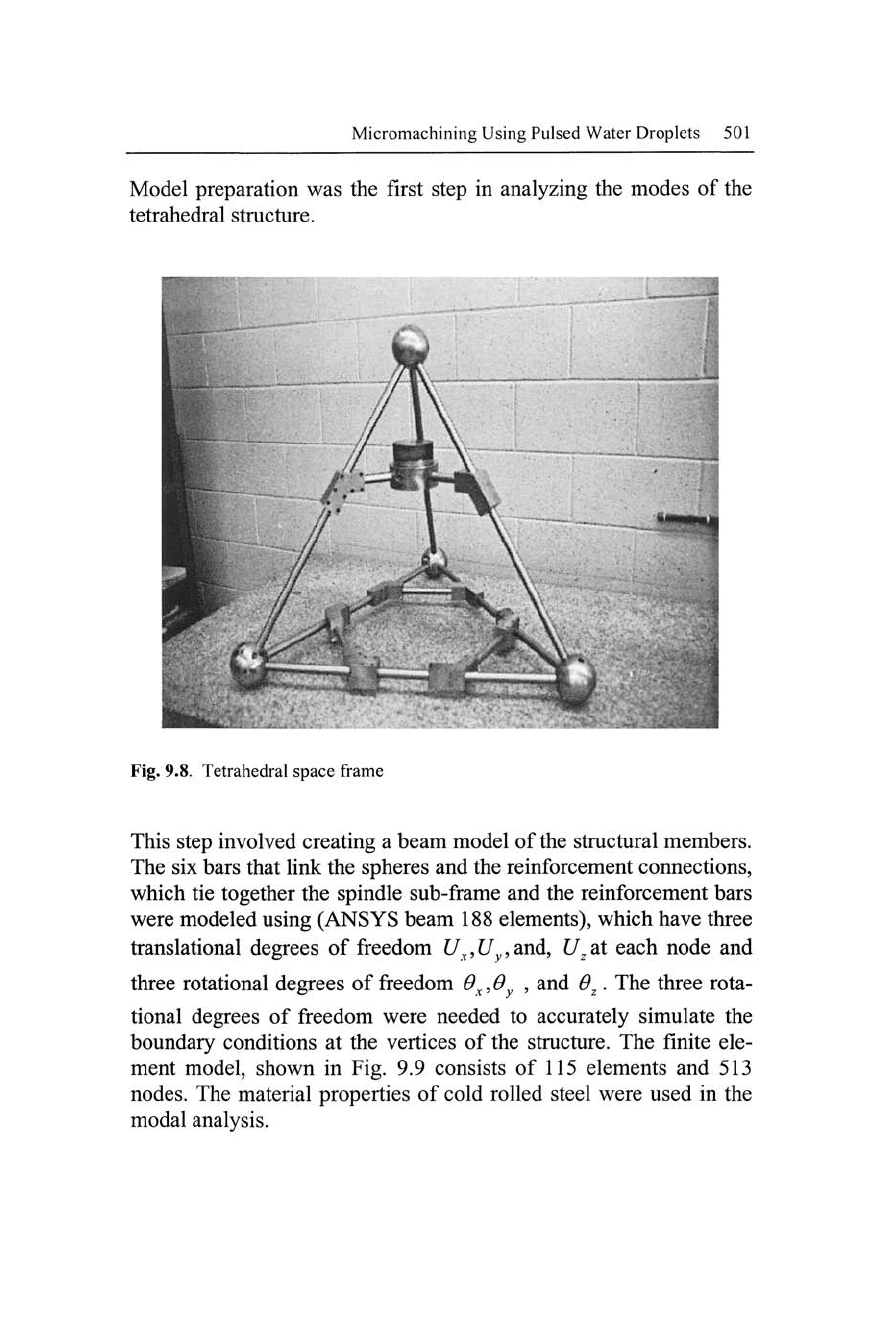
Micromachining Using Pulsed Water Droplets 501
Model preparation was the first step in analyzing the modes of the
tetrahedral structure.
Fig. 9.8. Tetrahedral space frame
This step involved creating a beam model of the structural members.
The six bars that link the spheres and the reinforcement connections,
which tie together the spindle sub-frame and the reinforcement bars
were modeled using (ANSYS beam 188 elements), which have three
translational degrees of freedom £/,,£/,and,
U
z
at
each node and
three rotational degrees of freedom
0
x9
O
y
, and 6
z
. The three rota-
tional degrees of freedom were needed to accurately simulate the
boundary conditions at the vertices of the structure. The finite ele-
ment model, shown in Fig. 9.9 consists of 115 elements and 513
nodes.
The material properties of cold rolled steel were used in the
modal analysis.
